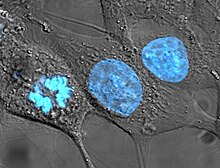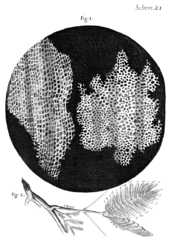Cell theory

In biology, cell theory is a scientific theory first formulated in the mid-nineteenth century, that living organisms are made up of cells, that they are the basic structural/organizational unit of all organisms, and that all cells come from pre-existing cells. Cells are the basic unit of structure in all living organisms and also the basic unit of reproduction.
Cell theory has traditionally been accepted as the governing theory of all life,[1] but some biologists consider non-cellular entities such as viruses living organisms[2] and thus disagree with the universal application of cell theory to all forms of life.
History
With continual improvements made to
Microscopes
The discovery of the cell was made possible through the invention of the microscope. In the first century BC, Romans were able to make glass. They discovered that objects appeared to be larger under the
An extensive microscopic study was done by
Optical microscopes can focus on objects the size of a
-
A reproduction of Anton van Leeuwenhoek's 17th century microscope with magnification of up to 300x[6]
-
Robert Hooke's microscope setup, as depicted in Micrographia
Discovery of cells

The cell was first discovered by
Cells in animal tissues were observed later than those in plants because their tissues are fragile and difficult to study. Biologists believed that there was a fundamental unit to life, but until Henri Dutrochet were unclear what it was. Besides stating “the cell is the fundamental element of organization”, Dutrochet claimed that cells were also a physiological unit.[7]
In 1804,
Cell theory


Credit for developing cell theory is usually given to two scientists:
- 1. All living organisms are composed of one or more cells
- 2. The cell is the most basic unit of life
Schleiden's theory of free cell formation through crystallization was refuted in the 1850s by
- 3. All cells arise only from pre-existing cells
However, the idea that all cells come from pre-existing cells had already been proposed by Robert Remak; it has been suggested that Virchow plagiarized Remak.
Modern interpretation
The generally accepted parts of modern cell theory include:
- All known living things are made up of one or more cells[13]
- All living cells arise from pre-existing cells by division.
- The cell is the fundamental unit of structure and function in all living organisms.[14]
- The activity of an organism depends on the total activity of independent cells.[15]
- Energy flow (metabolism and biochemistry) occurs within cells.
- Cells contain DNA which is found specifically in the chromosome and RNA found in the cell nucleus and cytoplasm.[16]
- All cells are basically the same in chemical composition in organisms of similar species.
Opposing concepts
The cell was first discovered by Robert Hooke in 1665 using a microscope. The first cell theory is credited to the work of
Membrane and bulk phase theories
Two opposing concepts developed within the context of studies on
Harvey and Danielli (1939) proposed a lipid bilayer membrane covered on each side with a layer of protein to account for measurements of surface tension. In 1941 Boyle and Conway showed that the membrane of frog muscle was permeable to both K+
and Cl−
, but apparently not to Na+
, so the idea of electrical charges in the pores was unnecessary since a single critical pore size would explain the permeability to K+
, H+
, and Cl−
as well as the impermeability to Na+
, Ca+
, and Mg2+
.
Over the same time period, it was shown (Procter and Wilson, 1916) that gels, which do not have a semipermeable membrane, would swell in dilute solutions.[citation needed]
concentration. Some criticisms of the membrane theory developed in the 1930s, based on observations such as the ability of some cells to swell and increase their surface area by a factor of 1000. A lipid layer cannot stretch to that extent without becoming a patchwork (thereby losing its barrier properties). Such criticisms stimulated continued studies on protoplasm as the principal agent determining cell permeability properties.[citation needed
In 1938, Fischer and Suer proposed that water in the protoplasm is not free but in a chemically combined form—the protoplasm represents a combination of protein, salt and water—and demonstrated the basic similarity between swelling in living tissues and the swelling of gelatin and fibrin gels. Dimitri Nasonov (1944) viewed proteins as the central components responsible for many properties of the cell, including electrical properties. By the 1940s, the bulk phase theories were not as well developed as the membrane theories. In 1941, Brooks and Brooks published a monograph, "The Permeability of Living Cells", which rejects the bulk phase theories.[citation needed]
Steady-state membrane pump concept
With the development of
The modern view of the plasma membrane is of a fluid lipid bilayer that has protein components embedded within it. The structure of the membrane is now known in great detail, including 3D models of many of the hundreds of different proteins that are bound to the membrane. These major developments in cell physiology placed the membrane theory in a position of dominance and stimulated the imagination of most physiologists, who now apparently accept the theory as fact—there are, however, a few dissenters.[citation needed]
Reemergence of bulk phase theories
In 1956, Afanasy S. Troshin published a book, The Problems of Cell Permeability, in Russian, in which he showed that permeability was of secondary importance in determining the patterns of equilibrium between the cell and its environment. Troshin showed that cell water decreased in solutions of galactose or urea although these compounds did slowly permeate cells. Since the membrane theory requires an impermanent solute to sustain cell shrinkage, these experiments cast doubt on the theory. Others questioned whether the cell has enough energy to sustain the sodium/potassium pump. Such questions became even more urgent as dozens of new metabolic pumps were added as new chemical gradients were discovered.[citation needed]
In 1962, Gilbert Ling became the champion of the bulk phase theories and proposed his association-induction hypothesis of living cells.[19][20][21]
See also
- Cell adhesion
- Cytoskeleton
- Cell biology
- Cellular differentiation
- Germ theory of disease
- Membrane models
References
- ISBN 978-1259095191.
- PMID 26965225.
- ^ National Geographic Society. (2019, May 22). "History of the Cell: Discovering the Cell". Retrieved November 05, 2020.
- ^ S2CID 8297229.
- ^ S2CID 7338204. Archived from the originalon 2015-06-03.
- ^ "A glass-sphere microscope". Funsci.com. Archived from the original on 11 June 2010. Retrieved 13 June 2010.
- ^ Dutrochet, Henri (1824) "Recherches anatomiques et physiologiques sur la structure intime des animaux et des vegetaux, et sur leur motilite, par M.H. Dutrochet, avec deux planches"
- ^ Kalenderblatt Dezember 2013 – Mathematisch-Naturwissenschaftliche Fakultät – Universität Rostock. Mathnat.uni-rostock.de (2013-11-28). Retrieved on 2015-10-15.
- ^ Sharp, L. W. (1921). Introduction To Cytology. New York: McGraw Hill Book Company Inc.
- ^ Schleiden, M. J. (1839). "Beiträge zur Phytogenesis". Archiv für Anatomie, Physiologie und wissenschaftliche Medicin. 1838: 137–176.
- ^ Schwann, T. (1839). Mikroskopische Untersuchungen über die Uebereinstimmung in der Struktur und dem Wachsthum der Thiere und Pflanzen. Berlin: Sander.
- PMID 3538915.
- ^ Wolfe
- ^ Wolfe, p. 5
- PMID 20934643.
- ^ Wolfe, p. 8
- ISBN 0306414090.
- PMID 19872189.
- PMID 19256352.
- PMID 5884012.
- ^ Ling, Gilbert Ning (1962). A Physical Theory of the Living State: The Association-induction Hypothesis. Blaisdell Publishing Company.
{{cite book}}: CS1 maint: date and year (link)
Bibliography
- Tavassoli, M. (1980). "The cell theory: a foundation to the edifice of biology". American Journal of Pathology. 98 (1): 44. PMID 6985772.
- Turner, W. (January 1890). "The Cell Theory Past and Present". Journal of Anatomy and Physiology. 24 (Pt 2): 253–87. PMID 17231856.
- Wolfe, Stephen L. (1972). Biology of the cell. Wadsworth Pub. Co. ISBN 978-0-534-00106-3.
External links
- Mallery, C. (2008-02-11). "Cell Theory". Archived from the original on 2018-12-25. Retrieved 2008-11-25.
- "Studying Cells Tutorial". 2004. Retrieved 2008-11-25.

![A reproduction of Anton van Leeuwenhoek's 17th century microscope with magnification of up to 300x[6]](http://upload.wikimedia.org/wikipedia/commons/thumb/d/de/Leeuwenhoek_Microscope.png/180px-Leeuwenhoek_Microscope.png)

